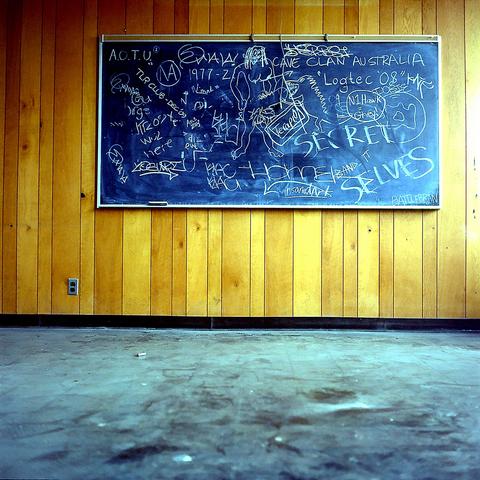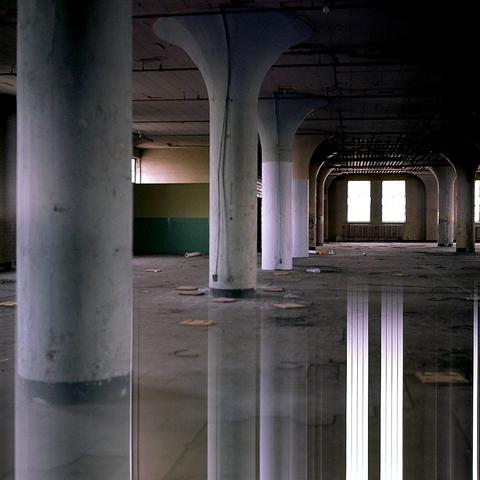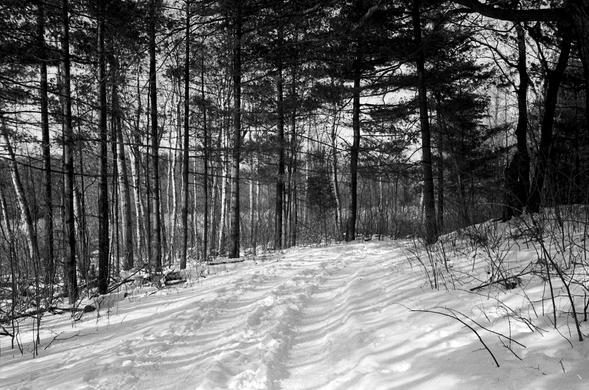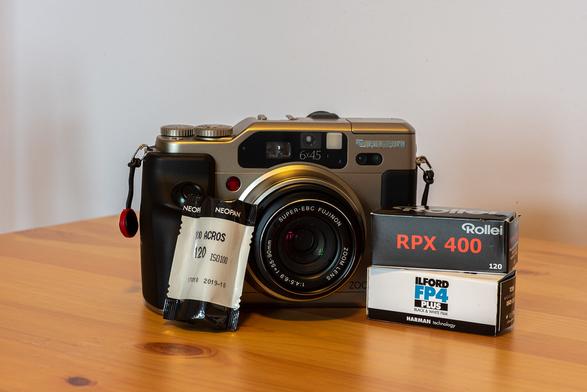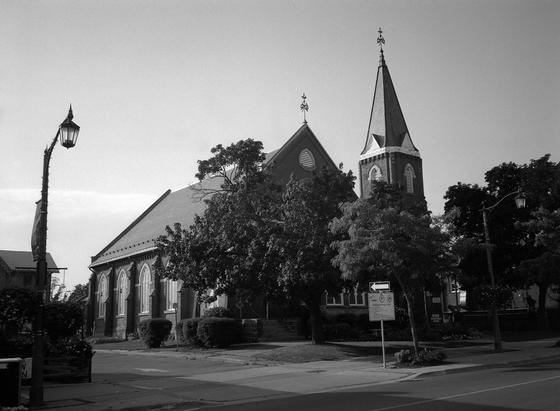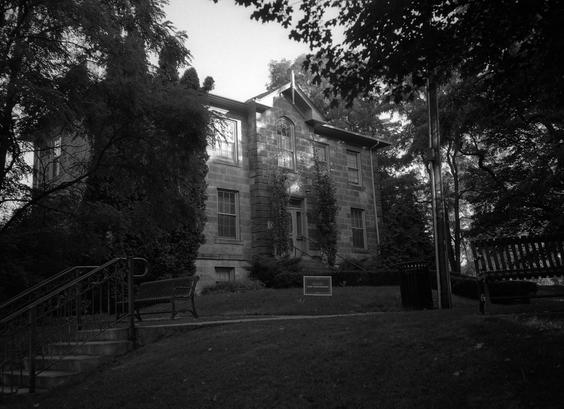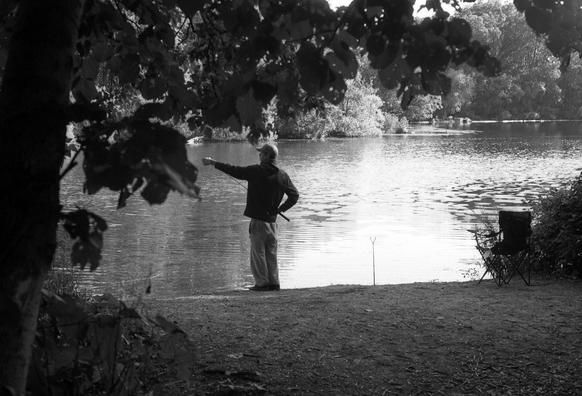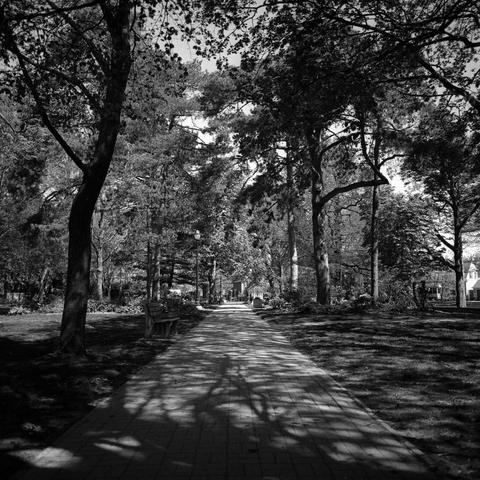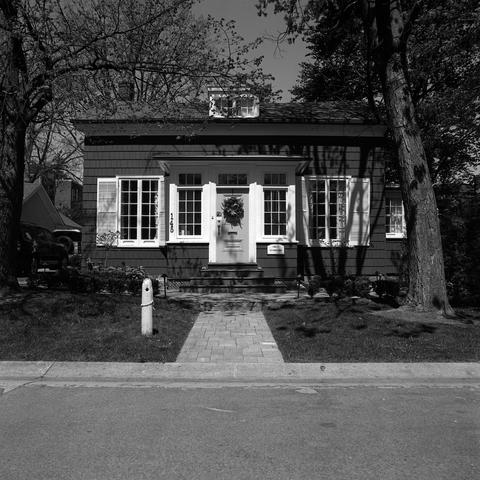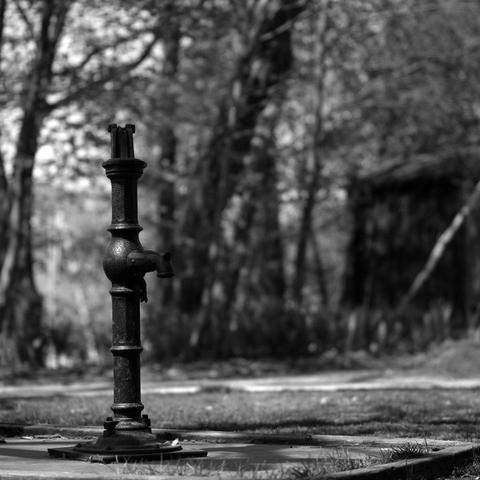Camera Review Blog No. 138 – Nikon D750
And now for something completely different. I know I'm better known for my reviews of film-based cameras, but I have reviewed a digital camera here before, back when I got the camera that this one replaced. In fact, the Nikon D750 marks two, not three things. First, it marks a return to an SLR as my digital camera; second, it marks the return to the Nikon Digital system. And finally, a digital camera that I like using a lot. It's not to say the a6000 was an unenjoyable camera to operate; the only complaint was that the system continued to be limited. Yes, I could use almost all my manual focus lenses through adapters, but I only had a single native lens for the camera. So back in 2020, when I started fleshing out the idea of superseding the a6000 as a primary digital, I needed to make a list of requirements. Because that's what you do as a trained systems analyst and information technology professional, you use those skills to make a major decision. I looked at my two major autofocus lens systems, Minolta Maxxum and Nikon F. That meant that I could go with a Sony or Nikon because I did not want yet another camera system, I don't have the room, and I also wanted to have the ability to share lenses. I also needed the camera to be a full-frame that being the 36x24mm form factor because having used crop sensors for my entire life in digital cameras and having used 35mm for so long; I wanted to have my lenses acting the same way on either my 35mm SLR or my digital SLR. While Nikon has many options, Sony has two, the a99 and the recently released a99II. I also would not be averse to a used camera. But when I compared my two lens systems, I have more lenses for Nikon, double when you count the manual focus lenses, which do count because they're all (save one, but it's a PC lens) compatible with Nikon digitals. Nikon became the clear winner, with the initial choice being a D f , but then I realized I needed the camera also to handle video, which the D f does not. Then while chatting with the fine folks at Burlington Camera about this conundrum, the D750 was forwarded. After some looking and chatting with fellow Alliance members, the D750 became the clear winner.
Camera Specifications
Make: Nikon
Model: D750
Type: Single Lens Reflex
Sensor: 24x36mm CMOS Sensor, 24.93 megapixels
Storage: SD Card Slot (2x)
Lens: Interchangeable, Nikon F-Mount
Shutter: Electronically controlled vertical-travel focal-plane shutter, 1/4000″ - 30″ + Bulb, Time
Meter: TTL Exposure Metering, RGB Sensor, EV 0 ~ EV20 @ ISO-100, ISO-100 - ISO-12800
Autofocus: Nikon Advanced MultiCam-3500, Phase Detection TTL Meter
Year of Manufacture: 2014 - 2020
Nikon D750 with the Nikkor 50mm 1:1.4D lens without the MB-D16 Grip
Nikon D750 with the Nikkor 50mm 1:1.4D lens and the MB-D16 Grip
Background
The history of digital image capture is a modern one. Simultaneously, many cameras I've reviewed in the past can trace their linage back to the mid to late 19th century; digital imaging is certainly one from the mid 20th century. The earliest examples of what would become the key to digital imaging began in 1953, and the principle of complementary symmetry was introduced by George Sziklai. Bell Labs produced the first Metal-Oxide-Semiconductor field-effect transistor in 1959 based on Sziklai's work. RCA's Paul Weimer's TFT Complementary Circuits in 1962 laid the basis for a CMOS or Complementary Metal-Oxide Semiconductor. Willard Boyle and George E. Smith from Bell Labs worked on a product to produce semiconductor bubble memory and use MOS technology to find a digital storage medium rather than magnetic. Boyle and Smith hit on the idea of creating a series of MOS capacitors in a row and use an electrical signal to charge them, and in 1969, the idea of a Charge Bubble Device. A paper in 1970 listed the idea of these Charged Coupled Devices or CCD to use them for memory, delay line, shift register, or an imaging device. Two companies latched onto the idea of using these CCDs and CMOS devices as imaging sensors: the first, a California computer firm, Cromemco. While the company produced Z80 based microcomputers, a happy accident saw them determine that a CMOS memory chip (1024 byte chip) with the opaque chip cover replaced by glass could record an image. By 1974 with the Altair 8800 microcomputer's arrival, they could use that as a digitizer to render and display their digital images. In 1975 they introduced the Cyclops with a resolution of 32×32 pixels. When paired with a modified Altair 8800 that used a device to save programs also designed by Cromemco and a graphics card to connect the computer to a TV, they could produce a commercially viable digital imaging system. Little did the California company know that a Kodak engineer Steve Sasson had been tasked with a similar project by the photographic giant on the other side of the United States. Sasson giving a 100×100 pixel CCD sensor, was determined to find some photographic use for CCD technology. Sasson built a beast. The Sasson Camera produced a 100×100 pixel black & white image using a lens taken from a Super8 camera, a standard audio cassette recorder, sixteen batteries, and an analogue-to-digital converter. But unlike the Cyclops, Kodak kept the Sasson camera under wraps, not wanting to undercut their film production. But the genie was out of the bottle, and the idea of digital images took off, and the application of digital imaging was many and numerous and not just for the average person.
Nikon D750 + AF Nikkor 28-105mm 1:3.5-4.5DNikon D750 + AF Nikkor 35mm 1:2DNikon D750 + AF-S Nikkor 14-24mm 1:2.8GNikon D750 + AF Nikkor 35mm 1:2D
The two big giants in the film were soon developing their digital image sensors, Kodak and Fuji. And by the 1980s, the race to release a digital camera was about to come to a close. Kodak, under a government contract, released their first sensor, the M1, in 1987, a CCD sensor with a resolution of 1 megapixel. They managed to modify a Canon F-1 to accept the chip and a 60 megabyte SCSI hard drive that had space to store 60 images. A SCSI (Small Computer System Interface) was key as it was the fastest method to read/write files to a hard drive. But the Kodak Tactical Camera never went beyond the prototype phase. Nikon began developing their own digital camera as early as 1986, the first being the prototype SVC or Still Video Camera with digital capture and analogue storage. Nikon would take these lessons and begin the parallel development of digital camera technology. The first would drop in 1988 proved to be the year digital hit the stage. Both Fuji and Nikon released their first digital cameras. Nikon's QV-1000C, based around a 380,000-pixel sensor, was a full SLR with interchangeable lenses (QV-Mount, two lens options) and touted as a Still Video Camera. However, the real winner was Fuji's offering, the DS-1P that included a memory card that could store ten images. Prototype DS-1P would be further refined and turn into the world's first digital camera to be sold commercially, the DS-X. The slim DS-X looked like the day's point-and-shoot cameras, albeit smaller, and took a credit card-sized 2MB memory card. That same year, Kodak released their prototype digital SLR or DSLR, the ECam D-5000, the ultimate grandfather of all future DSLRs, based around their 1.3-megapixel sensor. Rather than pursue their camera design, Kodak instead decided to get digital cameras into professional photographers' hands to take existing film SLRs and convert them into digital cameras. Nikon would do something similar taking the Nikon F4 and working on behalf of NASA convert it into a digital camera.
Nikon D750 + AF DC-Nikkor 105mm 1:2DNikon D750 - AF Nikkor 28-105mm 1:3.5-4.5DNikon D750 - AF Nikkor 28-105mm 1:3.5-4.5DNikon D750 - AF-S Nikkor 14-24mm 1:2.8G
The Kodak Digital Camera System (DCS) was an adapted Nikon F3. The F3 was an ideal choice given that the camera was already popular among photojournalists, had electronics, notably the contacts for the MD-4 drive. These could allow the camera to properly interface with the CCD image sensor and the massive Digital Storage Unit (DSU) that had to be carried on the shoulder that held the processor and storage for the images. Storage was a traditional 200MB SCSI drive with space to store 156 RAW images or 600 JPG compression. Other options for the DSU included a keyboard to caption images, a modem to transmit the images to the home office, and even a JPG compression board. Released in 1991, the DCS 100, as its name was retconned to later, sold for 20,000$ for the base model. Overall, 987 units were sold. But the DCS 100 was not exactly user friendly and not exactly easily used in the field with the DSU over your shoulder or in a backpack. Kodak, taking advantage of improvements in miniaturization, released the DCS 200 in 1992. Using a Nikon F-801s, the DCS 200 was an all in one unit that added a massive sensor and processor unit that stuck out like a big battery pack and motor drive (think about the massive system used on the Nikon F and F2 to get an idea). The trouble was that storage was reduced to an 80Mb SCSI drive. During these early systems, the sensors continued to be CCD based, but in 1993 CMOS sensors began to appear, but usually in smaller lower-quality roles such as webcams, imaging devices like fax machines and copiers, and later cellphones (the first being in 1999). Kodak's next offering, the DCS 400, came out in 1994 and was based around the Nikon F90x and featured for the first time solid-state memory in the form of a PCMCIA card and a 1.5 megapixel sensor, though later models, namely the DCS 460 in 1995 came with a 6.1 megapixel sensor. While Kodak continued to adapt both Nikon and Canon film SLRs for their purposes, Nikon wanted in on the game and teamed up with Fuji to make it happen. The Nikon NASA F4 or NASA Electronic Still Camera (ESC) was an advanced set of accessories that first flew aboard the Space Shuttle Discovery (STS-48). The centre of the system was a heavily modified F4 equipped with a 1 megapixel monochrome CCD sensor that captured a square image at 1024×1024 resolution; most camera functions were controlled by a Wildcard 88 computer based around an Intel 80C88 8MHz processor. Storage was removable hard drives that stored 40 images. The remaining items were called HERCULES or Hand-held Earth-oriented Real-time Cooperative, User-friendly, Location, targeting, and Environmental System.
Nikon D750 - AF Nikkor 35mm 1:2DNikon D750 - AF Nikkor 28-105mm 1:3.5-4.5DNikon D750 - AF Nikkor 35mm 1:2DNikon D750 - AF Nikkor 35mm 1:2D
In 1995 Nikon and Fuji released the E2/Fujix DS-505. The camera-based around a 2/3rd inch CCD sensor with a 1.3-megapixel resolution. With such a small size, the sensor carried a rating between ISO-800 and ISO-3200, or equivalent to ISO-50 to ISO-200 for a full-frame sensor. The E2 also took standard Nikon F-Mount lenses; the E2s/Fujix DS-515 had triple the frame rate and buffer size from the E2/505 models. Storage was on a solid-state PCMCIA card and could be downloaded to a computer via SCSI or directly connected to a TV for viewing. Moderate improvements in 1996 resulted in the E2N/DS-505a and E2Ns/DS-515a. Nikon and Fuji further improved the E-Series in 1999, now using a Nikon F100 as the base for the camera, results in the E3 and E3s or Fujix DS-560 and DS-565. They again used that small CCD sensor with a 1.4-megapixel resolution but improved metering and autofocus. But the problem remained that the E-Series remained a bulky camera, small by the standards set by the Kodak DCS series, but still not a clean design. When Kodak released the DCS 600 in 1999 based around the Nikon F5 that looked like a proper SLR and only slightly larger than a stock F5, Nikon knew they had to up their game. Nikon would use their F5 as a starting point but designed the internals from the ground up. Starting as far back as 1996, Nikon envisioned a larger sensor, smaller than a standard 35mm negative, but rather an APS negative, the "Classic" format (APS-C) of 23.7×15.6mm. The trouble was that no sensor manufacturer would sign on to help Nikon. While I'm unclear which company signed on, I would guess either Fuji or Sony decided to manufacture the new sensor for Nikon. The same year Kodak released the DCS 600, Nikon struck back with the D1, and Kodak's hold over the digital SLR market wavered for the first time. The Nikon D1 featured a 2.7 megapixel APS-C sized CCD sensor or a DX-format, as Nikon would call them.
Nikon D750 - AF-S Nikkor 28-70mm 1:2.8DNikon D750 - AF-S Nikkor 28-70mm 1:2.8DNikon D750 - AF-S Nikkor 28-70mm 1:2.8DNikon D750 - AF-S Nikkor 28-70mm 1:2.8D
The D1 used the Compact Flash format (2GB max size) first introduced in 1994 and an IEEE 1394 (Firewire) connector to download to your computer. Nikon would release two other variants of the D1, the D1H and D1X. Full-Frame, 36x24mm sensors, began to see a limited release in 2000 with Canon and Pentax dabbling in the format, and CMOS sensors were beginning to catch on for wider use in digital cameras. In 2002 Nikon released a semi-pro DSLR, the D100. Despite being named the D100, the camera took more after the Nikon F80 than the F100. Based around a 6.1-megapixel DX CCD sensor, the D100 offered up a USB interface to connect to your computer. It proved popular enough that Nikon further improved the design and released in 2005 the D200 with a 10.1-megapixel DX sensor. The D200 offered up a tonne of improvements for autofocus and metering that Nikon used in their F6. In 2007, CMOS sensor technology had surpassed that of CCDs and Nikon installed a Full-Frame of FX sensor in their new D3 rated at 12.1 megapixels. Similarly, the D300 was released that same year using a DX CMOS sensor at 12.3 megapixels. By 2008, HD video (720p initially) began to show up in DSLRs with the D90 from Nikon and Canon's EOS 5D Mark II is the first to feature the option. In 2008 Nikon downsized their D3 and released the D700, the first semi-pro DSLR with a range of professional features and 12.1 megapixel CMOS FX sensor. While the D700 was replaced by the improved D800 and a more advanced consumer D600 came out, the cancellation of the D700 in 2012 left a small gap in Nikon's lineup. The 2012 Nikon Df introduced a retrostyled DSLR based around a Nikon FM3a and introduced lightweight materials and a 16 megapixel FX sensor. The follow up to the D700 came out in 2014, the Nikon D750. And the D750 offered up many features not yet seen in a professional or semi-pro level DSLR. The 24 megapixel FX sensor was of an all-new design with improved sensitivity. It also added a tilting screen and WiFi. And even improved video functions and audio control. But also put all of this into a lightweight package. The camera proved popular enough that despite being cancelled in 2020, the D780 continued that linage.
Nikon D750 - AF-S Nikkor 28-70mm 1:2.8DNikon D750 - AF Nikkor 28-105mm 1:3.5-4.5DNikon D750 - AI Nikkor 28mm 1:3.5Nikon D750 - AF Nikkor 50mm 1:1.4D
Impressions
I did not expect the D750 to be small; I honestly believe that the camera is actually smaller than my D300 and just a touch bigger than my D70s. Either way, despite being small, I used the camera for much of the year without getting the additional battery grip. I eventually got the grip to provide that second battery when out photographing at events and video work that requires a bit more power consumption. And the grip does add that needed balance for the larger lenses in my collection, my f/2.8 trio being the primary reason. While I find the grip a necessary accessory if you're only shooting short primes and smaller zooms, you won't need that grip unless you're doing a lot of shooting and need that second battery. And one thing that the grip does add is the capacity to run the camera on AA batteries, and the tray comes with the grip as a standard accessory when you buy the grip. But honestly, the D750 is an amazing lightweight camera for what it can produce. If you're used to working with Nikon cameras, adapting to the D750s is easy, and the funny part is that the digital camera has more dials on it than my F5, such as the mode dial! But there are a lot of buttons on the camera. Thankfully the manual is handy in keeping track of what does what; the best thing you can actually do is figure out which buttons you need to do what you want with the camera. As long as you can quickly get to those buttons, the rest don't matter too much. I quickly found that all the buttons you need for general still photography operation are easily reached and close to where your hands sit. That said, a couple of buttons are a little too close to other buttons, and I often push the wrong one. The biggest one I have is the metering mode and the record button for video. In the winter, I would often press the meter mode button rather than the record button. Thankfully I always confirm on the camera that it's actually recording before I go and step in front of the camera. Another button that proved a bit troublesome early on is the focus mode. That traditional two-position switch allows you to select either Auto-Focus or Manual Focus, but in the centre is an actual button. You press that button and then use both command dials to set the focus mode (single or continuous) along with the focus group mode (there are a lot!). Other than that, the camera's controls are well laid out, and the shutter button is rather clean, and the shutter sound is quiet but still satisfying. The external connections to the camera are easily accessed, the dual card slots are behind a sliding cover, and simple hinged covers for your shutter cable, along with headphones and microphone (make sure you plug your microphone into the right plug. Sadly the D750 uses a different connector for the remote shutter cable than the cable I have for my F5 (which I originally purchased for my D300). The connector is the same as my D70s! Ah well, I made a point to order a new one with a few more advanced features than the stock Nikon version.
Nikon D750 - AF-S Nikkor 28-70mm 1:2.8DNikon D750 - AF DC-Nikkor 105mm 1:2D
Nikon D750 - AI-S Nikkor 105mm 1:2.5Nikon D750 - AF-S Nikkor 28-70mm 1:2.8D
Experiences
Having plenty of experience working with Nikon SLRs, both digital and 35mm, makes using the D750 a breeze. And I can honestly say it is like coming home after a long time away. While I'm used to a big heavy camera, the smaller form of the D750 is still comfortable in hand and easily used with or without a grip. I can honestly say that when I start to retake trips where size is an issue on the camera kit, I will be okay using the camera without a grip and a single lens, and it is rather compact and easy to use. All the buttons are easily accessed, and it is a nice blend of physical and menu-based controls. As I mentioned in the previous paragraph, the layout is intuitive and easily figured out with minimal manual checking. The one downside is that a battery grip helps with the balance if you are using larger lenses. My prime lenses (35/2D, 50/1.4D, and 105/2D) along with my cheap zoom (28-105/3.5-4.5D) are great on the camera without the grip when I get into my larger fixed aperture zoom lenses (14-24/2.8G, 28-70/2.8D, and 70-200/2.8G) that grip is a lifesaver. When it comes to battery life, if you're only working with still photography, then the battery has a long life. Honestly, I can be out shooting for a couple of weeks before it needs a charge. And having that grip double the life span of a charge and adds the option of using AA batteries (stock, the tray comes with the MB-D16)! The autofocus can be a bit touchy at times, especially when working in fully automatic mode. Sometimes, it does have a hard time locking onto a focus point, but having that focus mode button right there allows easy adjustment of the focus mode on the fly. But the autofocus speed on both the older Type-D lenses and newer AF-S lenses is snappy and accurate. Exposure wise, the camera has an excellent meter, which is no surprise; I have never met a Nikon meter that was not bulletproof. The camera's viewfinder is big and bright, no matter the lens you have on the camera. And there is plenty of feedback in the lens, including an electronic rangefinder to help with manual focus with both your AF and MF lenses. The D750 also features a live view mode which is good and helpful combined with the articulated screen. I know that it would have been a lifesaver back in my exploring days. Especially at Photech, where I most certainly needed a respirator but using an SLR (D70s), I could not use the viewfinder while wearing the mask. The one interesting bit with the camera is the inclusion of dual SD slots; while this is nothing new, it is the first camera I've used that includes this feature. Originally I thought it was only a gimmick, but I'm starting to see the value in having these two slots. When I was shooting my first day out on my railroad project, I put in two cards, one card to store the still images, while the second card captured all the video files. Keeping the two separate so I did not accidentally import the video into my Lightroom library. But you can do so much more, it can act as cascade storage, so when one card fills up, it goes onto the second card without swapping them out, or on professional jobs, set them to duplicate so that the files are recorded on both cards in case, one card dies on you. Plus, the D750 has the capacity to support cards up to 256GB, which, even when shooting RAW format, is over 4,000 images per card which is insane!
Nikon D750 - AF-S Nikkor 70-200mm 1:2.8GNikon D750 - AF-S Nikkor 70-200mm 1:2.8GNikon D750 - AF-S Nikkor 70-200mm 1:2.8GNikon D750 - AF-S Nikkor 14-24mm 1:2.8G
Starting last year, I started working a bit more with video and producing content for my YouTube channel (you can see an example below), which is one of the main reasons for going with the D750 rather than a D f. And Nikon certainly put a lot of thought into the video system of the D750. I'm happy with the quality of the video I get from the camera. Working with the camera both in front of and behind the camera is an interesting experience. I haven't been able to figure out how to get the autofocus system to work well and in a consistent manner. I've gone to work with the lens in manual focus mode, pre-focusing and having the aperture stopped down to help with ensuring the subject (me) is in focus when in front of the camera. It is far easier to have someone working the camera. But there is also the audio quality; Nikon included a standard phone jack for an external microphone and one for your headphones as well. And it works with standard third-party equipment, I've worked with Rhode wireless microphones and an on-camera shotgun microphone, and both have delivered excellent audio quality. The internal microphone isn't anything to sneeze at either and is great for capturing ambient sound and even has wind cancellation, which again isn't perfect, but not bad for internal microphones, oh and it records in stereo.
Nikon D750 - AF Nikkor 28-105mm 1:3.5-4.5DNikon D750 - AF-S Nikkor 28-70mm 1:2.8DNikon D750 - AF-S Nikkor 70-200mm 1:2.8GNikon D750 - AF Nikkor 28-105mm 1:3.5-4.5D
Optics
One of the best parts of the D750 is the sheer amount of lenses available for use with the camera. At the same time, you cannot use your original Non-AI lenses unless they have been converted or AI'd, every other lens, AI, AI-S, Series E, AF (not F3AF), D-Type, G-Type, and E-Type. And also, AF requires an in-camera autofocus motor and AF-S lenses. That is a lot of glass and a lot of classic lenses. And perfect for a photographer in the same position as I'm in that has a massive collection of Nikkor optics. One of the biggest concerns is that the smaller manual focus lenses often look diminutive on these modern bodies. And sure, some do, but the short primes like the 50/1.4, 35/2.8, and 28/3.5 look rather good on the D750. Similarly, despite being small, the camera handles most of my prime lenses well, mainly my D-Type lenses. Sure the balance is thrown with my heavy zooms (14-24/2.8G and 70-200/2.8G), but it isn't too bad. But that isn't all the tricks the D750 has up its sleeve. The camera has a crop sensor mode that will only activate the appropriate elements of the imaging sensor when you attach a DX lens to the camera. That means that if you upgrade from a DX to an FX camera, you don't have to rush out and update all your lenses. The drawback is that you will have a smaller image being produced. But it makes a great stop-gap in the interim. And yes, you can also manually activate this mode and use it with your full-frame lenses. And the one thing that the D750 does support is the latest lens type from Nikon, the E-Type ( not Series E ), which uses an electromagnetic aperture rather than a mechanical link. I don't plan to update my AF-S lenses to the new type, but I'm happy with my kit.
Nikon D750 - AI Nikkor 28mm 1:3.5Nikon D750 - AF Nikkor 35mm 1:2DNikon D750 - AF-S Nikkor 28-70mm 1:2.8DNikon D750 - AF Nikkor 28-105mm 1:3.5-4.5D
Image Quality
While your lens choice has a lot to do with your image quality, I remember those first few shots trying the camera out in almost any condition I could get, and each time, the D750 delivered superb results. One thing that surprised me is how good the images look right out of the camera; in the past, I've always found digital images shot in RAW (NEF) format a little flat on the contrast. And I will boost those settings in Lightroom. But I have actually had to pull those settings back, or it over-saturates the images. One of the big complaints that I've read about the D750 is how it renders skin tones. But it may be me or my eye, but I've done several portraits with the camera and cannot find an issue with the skin tones. When it comes to low-light photography, the D750 shines. I have not shot the camera higher than ISO-3200, but even there, the noise is negligible, so much so that I don't even make any noise reduction in post-processing. And I regularly shoot the camera between ISO-400 and ISO-1600 without giving it a second thought. The one thing that I noticed with the camera is that there's not as much latitude in the way of recovery of details lost in highlights; on the a6000, I could clean up those highlights without a second thought or bracketing stacking images (HDRi). While not a bad thing, it is the one thing that I noticed between the two. The D750 is excellent and provides an enjoyable experience; while I've mainly been in front of the camera and setting everything up manually, I cannot complain about the footage quality. While you cannot do 4K on the camera (which is okay, I don't need that level of quality for YouTube videos on film photography), the 1080p 30fps is perfectly acceptable. And the audio controls built-in allow for wind cancellation, audio gain, and stereo recording with the built-in microphones.
Nikon D750 - AF Nikkor 28-105mm 1:3.5-4.5DNikon D750 - AF Nikkor 28-105mm 1:3.5-4.5DNikon D750 - AF Nikkor 28-105mm 1:3.5-4.5DNikon D750 - AI-S Nikkor 200mm 1:4
Lowdown
After going to a mirrorless system for several years, it felt far better to go back to my routes with a Nikon SLR. The D750, despite its age, is still an amazing camera with plenty of years of life left in the system. At the same time, you can use it easily with or without the grip making it perfect for travel. Not to mention the sheer level of compatibility with every lens I have in my tool kit. If you're looking for a way back into Nikon DSLRs, then even a used D750 will suit you well, but honestly, going with a D780 is an excellent choice. While Nikon is moving more into their mirrorless Z-System, an F-Mount will remain my Nikon camera of choice for many years to come. I'd like to give a special shoutout to Mike Eckman, Stephen Dowling, and Alan Duncan who both proved invaluable in making sense out of the history of digital imaging and this post would have suffered without their amazing input. Not bad for a group of mainly film shooters eh?
Further Reading
Don't just take my word on the D750, you can check out the reviews by other awesome camera reviewers!
Full Stop - Nikon D750 heads to the Cape
Photography Life - Nikon D750 Review
DPReview - Nikon D750 Review
Ken Rockwell - Nikon D750 Review
Digital Camera World - Nikon D750 Review
Imaging Resource - Nikon D750 Review
ShotKit - Nikon D750 Review
#camerareviewblogs #cambridge #camera #camerareview #canada #canadianwarplaneheritagemuseum #d750 #digital #dslr #elora #fx #gear #georgetown #guelph #hamilton #historicfortyork #kingston #milton #mississauga #niagaraonthelake #nikkor #nikon #nikond750 #nikondigital #oakville #ontario #review #stjacobs #toronto #uxbridge #woodstock
